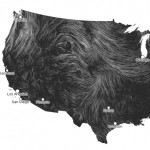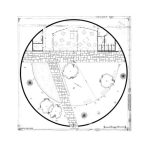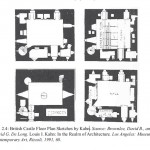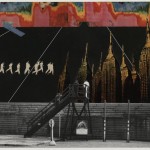There’s a fine line between fact and fiction, between a moment and a perfect representation of that moment. Melissa Denes, Picture Perfect, the Guardian, 15 October 2005.
Jeff (Jeffrey) Wall is a major Canadian photographer best known for his large-scale back-lit photographs and the corpus of theoretical texts that made him a major figure in Postmodern art.
Wall’s pursuit of avant-garde research through reference to past iconic paintings, – which he owns an extensive knowledge of -, is best shown in his Picture for Women (1979), a response to Édouard Manet’s Un bar aux Folies Bergère. Spontaneity à la Cartier-Bresson does not interest him, rather the illusion of recreating the “decisive moment”.
Digital composition is a slow tool that Wall has extensively used since 1991 and, notably, for his 1993 work A Sudden Gust of Wind (after Hokusai); yet, during the working process the artist also created a black and white collage (Study for ‘A Sudden Gust of Wind (After Hokusai) out of photocopied photographs and paper. The final work is the result of a digital composition process, during which Wall photographed actors over a period of five months in the Vancouver landscape in similar weather conditions and then adapted the photographed components (over 100 elements) together within a large tableau. The final work is staged in the manner of classical painting: the actors respond with surprise to the gust and sheets of papers are dispersed in the wind’s direction, escaping from the folder of one of the figures.
The gust of wind, already present in the Katsushika Hokusai woodcut reference (Yejiri Station, Province of Suruga, Part of the series Thirty-six Views of Mount Fuji, no. 35., 1832) is a conceptual device that Wall employs to engage the viewer’s eye and move it across the photograph.
 Katsushika Hokusai (1760–1849), Yejiri Station, Province of Suruga. Part of the series Thirty-six Views of Mount Fuji, no. 35, circa 1832. Woodblock color print
Katsushika Hokusai (1760–1849), Yejiri Station, Province of Suruga. Part of the series Thirty-six Views of Mount Fuji, no. 35, circa 1832. Woodblock color print
The singularity of the Study allows understanding Wall’s methods, as he used it
for working out aspects of the composition. It was done by photocopying black and white scan outputs, enlarging them, and patching them together. The main purpose was to plot out the position and sizes of the papers blowing in the air. I took individual pieces from the various original scans, copied them, and stuck them on the paper, changing them around to make the composition of the sky. This took quite a while, and the small pieces were moved around repeatedly. Each has a code number, so I could trace them back to a sheet of film. So the collage was really a working element in making the picture. (Faxed letter to Tate curator, February 1997.)
Formal composition is central in the work: a set of parallel vertical, horizontal and diagonal lines aids the artist in positioning the central elements of the scene: two leaning trees, the actors the landscape.
Small patches, misalignments in the trees bases and the different positions of the sheets indicate the elements that have been reworked later and the process of experimentation in the creation of the final work. “When I began working on the computer,” he says, “I realized you don’t have to do it all at once. Of course, it’s exciting trying to get everything in one shot, but working digitally slowed things down. It made the process more complicated and, I hope, deeper.”
 Jeff Wall, Study for ‘A Sudden Gust of Wind (After Hokusai)’, 1993, Purchased by Tate in 1997, http://www.tate.org.uk/art/work/T07235
Jeff Wall, Study for ‘A Sudden Gust of Wind (After Hokusai)’, 1993, Purchased by Tate in 1997, http://www.tate.org.uk/art/work/T07235
 Jeff Wall, A Sudden Gust of Wind (after Hokusai), 1993, Purchased by Tate with assistance from the Patrons of New Art through the Tate Gallery Foundation and from the Art Fund 1995, http://www.tate.org.uk/art/work/T06951
Jeff Wall, A Sudden Gust of Wind (after Hokusai), 1993, Purchased by Tate with assistance from the Patrons of New Art through the Tate Gallery Foundation and from the Art Fund 1995, http://www.tate.org.uk/art/work/T06951
Jeff Wall’s images © Jeff Wall.





Leave a Reply